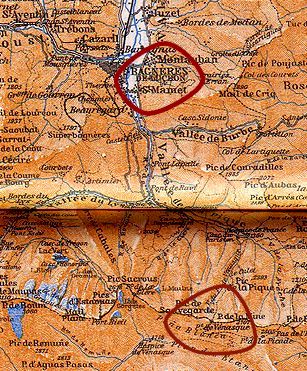|

A Short Tour of the Pyrenees Oriental

3. Around Bagneres-des-Luchon - to the
Port de Venasque
OK, so I lied a little bit about having no
plans for the week as there was one thing in particular that I wanted to
achieve: to walk from France into Spain. There is a rich history of
border crossing which stretches from Hannibal traversing with his
elephants to refugees fleeing the Spanish Civil War in the late 1930's
or Allied servicemen sneaking out of Vichy France a few years
later.
For about 10 years a copy of Kev Reynolds 'Classic Walks In The
Pyrenees' (1989 Oxford Illustrated Press) had been loitering
enticingly on my bookshelf, occasionally I would pull it down and thumb
through the routes: most of them are pretty serious undertakings
involving several days in the wilderness with only rope, crampons and an
ice axe for company. But the Port de Venasque stood out as not only achievable
in one day but also visually spectacular, taking in views of the
Maladeta glacier. There was only one negative comment - that 'this walk
should not be attempted before the end of June owing to avalanche danger
in normal years'. The Rough Guide and the Baedeker cover the same route
but made no comment about 'avalanche danger'. To be on the safe side we
decided to seek advice from the Tourist Office in Luchon where we were
told by a charming young lady that we could get as far as the Refuge but
beyond that, she summed up the likely conditions with a gallic
shrug.
We decided to go and see for ourselves, optimistically hoping that 12
years of global warming may have reduced the risk somewhat, nevertheless
we agreed beforehand that if conditions looked tricky then we would turn
back. We followed the road to the Hospice de France and parked in the discreet hollow next to the Hospice
(so discreet that the car park doesn't spoil the view!). The Hospice is tumble
down collection of buildings that were part of a medieval trading
route between France and Spain. The view south
is beautiful but two large patches of snow did give us
some cause for concern.
The path itself climbs steeply but as it was established for mule trains
is fairly easy walking. After an hour or so we had to ford the river which
was sluicing a huge quantity of snowmelt down the mountain, and a short
while later we were standing in front of the first snowfield which
snaked up into a gully high above us. Outsize melting
footfalls crossed the base of the field in a line about 20 metres long.
We stopped to debate our course of action, and decided to press on - the
distance was short and the field ended some 3/4 metres below us. In fact
so safe did we feel, we foolishly posed for photographs
halfway across -
foolishly, because within 2/3 minutes of reaching the other side we
heard a loud crack from somewhere in the gully above and moments later a
2 metre diameter snowball smashed itself into the rocks below. We are
not especially proud of this moment and recommend that in a
similar situation, you turn around and leave it for another day. We
pressed on, simply because we didn't fancy re-crossing what was an
unstable snowfield until the sun had dropped and the snow had firmed
up.
The second snowfield was somewhat smaller
(about 6 metres wide) and we crossed it briskly at its highest point
(where we had no fears about the snow above us). A short walk later we
climbed over the lip of the valley into a bowl fringed with Tolkienesque
peaks of black rock, covered in heavy snow and pools of snowmelt. The
path leveled out and picked its way past the lowest lake, an icy
blue/green pool half covered with dripping snow. We reached a second lip
which emerged behind the Refuge. The breathtaking scene of two more half
concealed frozen lakes glinting in the sunshine and the sharp outline of the peaks above us
convinced us that we were
going no further that day. We picked a sheltered spot and had some
lunch. Pouring over the map we managed to pick out the path which we
could see crossed diagonally over a 500 metre snowfield. It was disappointing
not to make the border but the wintry scene was ample compensation. The
1909 Baedeker has an enticing panorama of the view from the Port de
Venasque (click here to see it) - we will have to
go back to see it in colour.
As we munched on ham baguettes, a
helicopter dropped in with supplies for the Refuge. It's amazing to
think that someone lives in this wilderness from the beginning of June
onwards, even more amazing when we wandered over for a coke and were
served by a portly Frenchman wearing carpet slippers! After exploring
the bowl and admiring the view North we
headed back down the mountain. The snowfields were firm enough to allay
our avalanche fears but slippery enough for us to be worried about sliding
off. Back by the Hospice de France we spent an idle hour soaking
our hot feet in the cold water of the river as the
hazy valley slowly began to fill with cloud.
After driving back to Luchon we treated
ourselves to... yes a few beers and a slap up meal!
next: 4. Some
Cycling - Bagneres- de-Luchon to Salardu
| 
